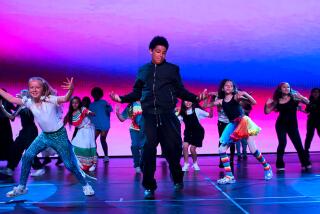DANCE : Spirit of India’s Festivals to Be Conveyed : The Arpana Dance Company will perform at the Irvine Barclay Theatre in the style of <i> bharata natyam, </i> a 2,000-year-old classical dance idiom of southern India.
- Share via
IRVINE — Each fall, music and song resonate throughout Indian homes and neighborhoods, morning prayers are offered, women prepare special lentil dishes, and excited children display the family doll or toy collection in a festival that celebrates the goddess of power, wealth and knowledge.
“When I was little, we had this train set which we were allowed to take out only once a year because it was so big,” said Ramya Harishankar, who moved from southern India to Irvine nine years ago. “It took up half a room and we had real sand and little sprouts growing on either side of the track for fields and water under the bridges.
“The (Navaratri) festival is really an occasion for the children to get creative and go all out,” said Harishankar, lead dancer and artistic director of the Arpana Dance Company, which will convey the form and spirit of Navaratri and other Indian festivals at 8 p.m. Friday at the Irvine Barclay Theatre.
Arpana will perform dances in the style of bharata natyam, a 2,000-year-old classical dance idiom of southern India that animates the poses of ancient temple sculptures, to explore the culturally rich and varied celebrations held each month, year round.
“The festivals are like holidays, like Christmas or Thanksgiving, and their purpose and meaning is manifold,” Harishankar said recently. “They are an occasion for the family to get together and have a feast or party, so to speak, and also an occasion for everybody to reestablish their spiritual ties.
“Another festival is dedicated to the goddess of knowledge. All students on that particular day have to take fruits and flowers and gifts to their teachers--schoolteachers, dance teachers, music teachers, any teacher who is widening their horizon.
“Then, of course, there is the harvest festival, which is a big thing to the people in the farming villages of the south. It’s like a thanksgiving for their bounty.”
The dancers of Arpana, who wear the traditionally elaborate, bejeweled dress of bharata natyam, will re-create the frequently ornate doll displays seen during Navaratri and express nine basic “emotions” associated with the nine-day festival and its goddess, the supreme lord in the feminine form, Harishankar said.
These emotions or “universal experiences” of love, disgust, wonder, fear, laughter, compassion, anger, valor and peace are also part of the language of bharata natyam, expressed through mime as well as body movement.
“We act out or interpret the words of songs using gestures, which are symbolic and very stylized,” she said. “We have gestures for almost anything you can think of. And we’re not just using our frame or trunk, but the eyes or the eyebrows or the little movement of the lips. Every little nuance has a meaning to it.”
First performed for ancient temple rituals, bharata natyam is typically performed by a solitary female who is free to improvise. While she does not alter ancient rudimentary elements, she need not conform to a predetermined combination of steps.
Harishankar will dance several such solos in the upcoming performance.
She has broken with tradition, however, in choreographing group dances for members of her company who will adhere to set patterns.
The 33-year-old, who hasn’t stopped dancing and performing since she began lessons at 6, previously veered from the norm when she eschewed the business training she received in college.
“In India, dance is not really a lucrative profession, so it was not considered something I could pursue. But after my undergraduate work, I couldn’t see myself sitting in front of a desk, 9 to 5, so I said ‘No, I’m going to dance, for whatever it’s worth.’ ”
Performing regularly in India, Harishankar didn’t find the same opportunities when she came to the United States with her husband.
So, while building her stage career, she opened a school in Irvine in 1982, aware of the need within the large Southern California Indian community.
She now performs more often and recently completed a 22-city solo U.S. tour, and has won a $2,000 support grant from the California Arts Council.
Her teaching took off from the start, however, and she currently rents facilities in Irvine, Fullerton and Cerritos to instruct about 100 charges every week.
Next month, for the second time, she will take students to India to perform during the cultural season in her native city of Madras.
“I had never planned to teach, but there were several Indian families here interested in having their children learn to dance. And it’s been very, very fulfilling. Several of the young girls have really taken to it and are performing well.”
More to Read
The biggest entertainment stories
Get our big stories about Hollywood, film, television, music, arts, culture and more right in your inbox as soon as they publish.
You may occasionally receive promotional content from the Los Angeles Times.










